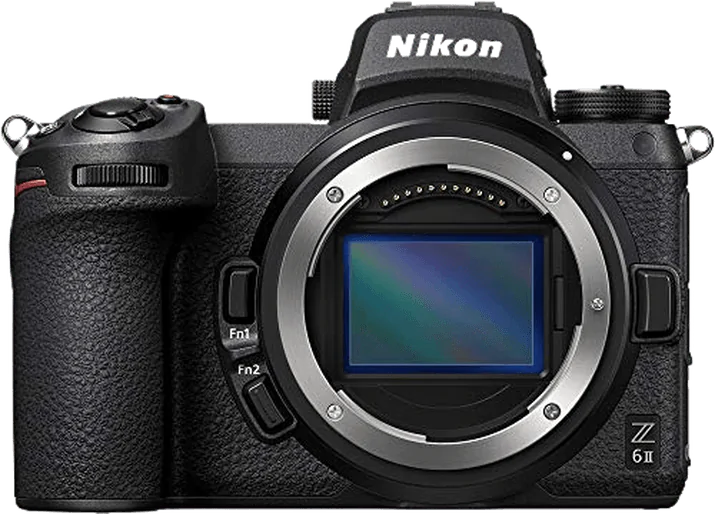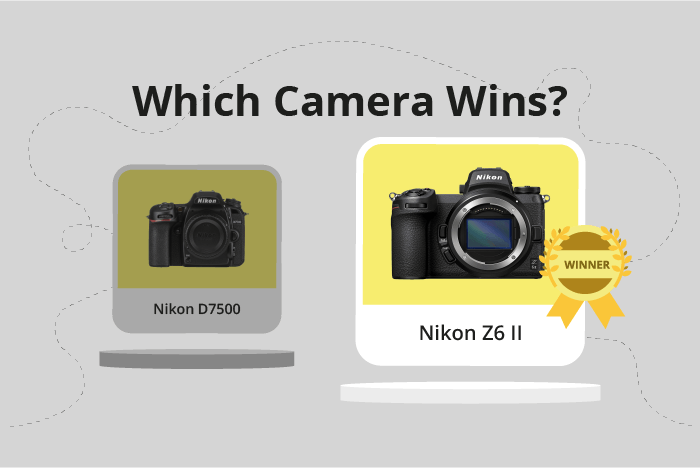Nikon D7500 vs Z6 II Comparison
Nikon D7500

Nikon Z6 II

The Nikon Z6 II comes out on top with a score of 83/100, while the Nikon D7500 trails behind at 70/100. Both cameras share a few specifications, such as their similar size and weight. The Z6 II measures 134 x 101 x 70mm and weighs 705g, whereas the D7500 is slightly larger at 136 x 104 x 73mm and weighs 720g.
The Nikon Z6 II outperforms the D7500 with its mirrorless technology, providing better image quality and faster shooting capabilities. Additionally, the Z6 II is a more recent release, hitting the market in 2020 compared to the D7500’s 2017 debut.
However, the Nikon D7500 has its advantages as well. Its launch price of $1250 is more affordable than the Z6 II’s $1995 price tag. This makes the D7500 a more budget-friendly option for those looking to invest in a quality camera without breaking the bank.
Taking all these factors into account, the Nikon Z6 II proves to be a superior camera with its higher score and advanced technology, while the Nikon D7500 still offers a solid option for those seeking a more budget-friendly choice.
Nikon D7500 vs Z6 II Overview and Optics
The Nikon Z6 II outperforms the Nikon D7500 in optics with a score of 83/100, compared to the D7500’s 68/100. Both cameras feature a CMOS sensor and have similarities in their specifications. However, the Z6 II surpasses the D7500 in several aspects, while the D7500 has its own advantages.
Shared specifications between the two cameras include the CMOS sensor type and a lens mount specific to their respective series – Nikon F DX for the D7500 and Nikon Z for the Z6 II. The Z6 II excels with a higher megapixel count of 24.5, faster shooting speed of 14, and a dual Expeed 6 processor. Additionally, it has a superior DXOMARK sensor score of 94 and a full-frame sensor size. The Z6 II also offers image stabilization, a feature absent in the D7500.
On the other hand, the D7500 has a lower megapixel count of 20.9, slower shooting speed of 8, and an Expeed 5 processor. Its DXOMARK sensor score is 86, and it has an APS-C sensor size. The D7500 does not provide image stabilization. Despite these disadvantages, the D7500’s Nikon F DX lens mount allows access to a wider range of lenses, which may be a deciding factor for some photographers.
Taking these factors into account, the Nikon Z6 II emerges as the superior camera in terms of optics, offering better image quality, speed, and stabilization. However, the Nikon D7500 has the advantage of a broader lens selection, which may appeal to photographers seeking versatility in their equipment. Ultimately, the choice between the two cameras depends on individual preferences and requirements.
Nikon D7500 vs Z6 II Video Performance
The Nikon Z6 II outperforms the Nikon D7500 in video capabilities, scoring 91/100 compared to the D7500’s score of 70/100. Both cameras share some common video specifications, such as 4K maximum video resolution, 3840 x 2160 maximum video dimensions, and built-in time-lapse functionality.
The Nikon Z6 II surpasses the D7500 in terms of maximum video frame rate, offering a remarkable 120fps, whereas the D7500 only provides 30fps. This significant difference allows the Z6 II to produce smoother, more detailed slow-motion footage, making it a superior choice for capturing fast-moving subjects or creating cinematic video effects.
On the other hand, the Nikon D7500 does not possess any clear advantages in video capabilities over the Z6 II. Both cameras share the same maximum video resolution and dimensions, as well as built-in time-lapse functionality. The main difference lies in the maximum video frame rate, where the Z6 II clearly excels.
Taking these factors into account, the Nikon Z6 II proves to be the better option for video performance. Its impressive 120fps maximum video frame rate enables users to capture high-quality slow-motion footage and achieve more refined video results. The Nikon D7500, while still offering 4K resolution and time-lapse functionality, falls short in comparison due to its limited 30fps maximum frame rate. Therefore, for those prioritizing video capabilities, the Nikon Z6 II is the superior choice.
Nikon D7500 vs Z6 II Features and Benefits
The Nikon Z6 II outperforms the Nikon D7500 in features, scoring 87/100 compared to the D7500’s 83/100. Both cameras share several specifications, such as a 3.2-inch screen size, touchscreen functionality, and the absence of GPS. Additionally, both models offer WIFI and Bluetooth connectivity.
The Nikon Z6 II excels with its screen resolution, boasting an impressive 2,100,000 dots, significantly higher than the D7500’s 922,000 dots. This higher resolution provides clearer and sharper image previews, aiding in better composition and focus. However, the Z6 II lacks a flip screen, a feature present in the D7500.
The Nikon D7500, despite its lower feature score, has the advantage of a flip screen. This feature allows for more versatile and convenient shooting angles, particularly useful for vlogging or capturing images from challenging perspectives. The D7500 falls short in screen resolution compared to the Z6 II, offering a less crisp viewing experience.
Considering the feature scores and specifications, the Nikon Z6 II stands out as the superior camera due to its higher screen resolution. This advantage allows for improved image preview and composition. On the other hand, the Nikon D7500’s flip screen offers versatility in shooting angles, making it a valuable choice for certain photography and videography needs. Ultimately, the choice between these two cameras depends on individual preferences and priorities in terms of camera features.
Nikon D7500 vs Z6 II Storage and Battery
The Nikon Z6 II outperforms the Nikon D7500 in storage and battery with a score of 71/100, compared to the D7500’s 43/100. Both cameras accept SD memory cards, but the Z6 II takes it further by also supporting CFexpress Type B / XQD (UHS-II compatible) cards and offering two memory card slots, providing more versatility and storage capacity than the D7500’s single slot.
The Z6 II also has USB charging, allowing for convenient charging options on the go, which the D7500 lacks. However, the D7500 excels in battery life with 950 shots per charge, more than double the Z6 II’s 410 shots. Both cameras use different battery types, with the D7500 using EN-EL15a and the Z6 II using the more advanced EN-EL15c.
Despite the D7500’s longer battery life, the Nikon Z6 II’s overall better storage capabilities and USB charging make it the superior choice in this category. The Nikon D7500 still offers a solid battery life for those prioritizing extended shooting sessions.
Nikon D7500 vs Z6 II – Our Verdict
Are you still undecided about which camera is right for you? Have a look at these popular comparisons that feature the Nikon D7500 or the Nikon Z6 II:

